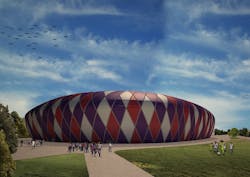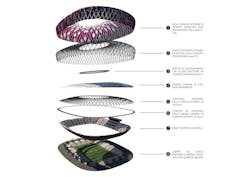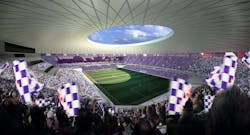An architect in Florence proposes a new soccer stadium as part of a larger urban redevelopment
By John Caulfield, Senior Editor
Last June, Rocco Commisso, the Italian-American chairman of the cable TV provider Mediacom Communications, took ownership of the Italian soccer club A.C.F. Fiorentina, based in Florence, Italy, where the team is known locally as the Viola, for its violet-colored jerseys.
The 69-year-old Commisso, who also owns the New York Cosmos soccer club in the U.S., (and who previously tried, but failed, to acquire the A.C. Milan club in Italy) has identified the need for Fiorentina to play its home games in a modern sports stadium. Right now, the club plays at Stadio Artemio Franchi, which opened in 1931.
According to Stadium Business, the Municipality of Florence in October approved a proposal to make a plot of land available for the potential development of a new stadium.
Florence-based Pierattelli Architetture has proposed a design for that new stadium as a component of a master plan that upgrades and expands the Novoli district in the northwest part of the city. That master plan focuses on improving the area’s existing subpar road network, and creating a new road network through the city’s food and beverage market known as Mercafir.
Pierattelli envisions a rhomboid-shaped stadium that resembles a large stone, higher on one side than the other, whose outer structure is clad in metal mesh of purple, white, and red, the team’s colors. The building would have 16 entrance points (four with turnstiles), and three grandstand rings, as well as a shopping mall and food service.
The 40,000-seat stadium would have a perimeter of approximately 600 meters (1,969 feet), a maximum width of over 200 meters, and a maximum length of 150 meters. Its height would range from 30 to 40 meters, with the highest section overlooking the grandstands in front of the new entrance.
The building is designed as a series of rings. A double-volume ring at the ground floor level channels the flow of people into different areas and levels. The second ring includes VIP grandstands, and 10 skyboxes of about 172 sf each and four of which would include meeting rooms. The last ring, which dominates the stadium, would house the dividers and columns that support the building’s entire internal structure.
There would also be an underground area for a swimming pool, dressing rooms, warm-up area and wellness center, and hospitality suite through which the press room, VIP grandstands and restrooms could be accessed.
Pierattelli's stadium design revolves around a series of architectural rings.
Pierattelli has positioned its design proposal as “a new vision of the city,” that amalgamates architecture, urban planning, and social life. The 148-acre Novoli neighborhood is currently lacking modern infrastructure. Pierattelli proposes that Viale Guidone, the city’s main traffic artery, be redirected as a one-way thoroughfare underground through a tunnel whose entrance would be near the city’s railway and whose exit would be in front of the city’s Palace of Justice. Ground-level pedestrian and cycle paths would be maintained.
Another road would be added that connects the city’s Piazza Artom with its Via dell’Olmatello, and divides the Mercafir in half, making part of this road exclusively for foot traffic, and “an island of peace within an area of inter-municipal traffic,” states the architect. The Municipality of Florence has opted to put part of the Mercafir area up for sale, with a prospect of that land being purchased for the development of the new stadium, according to Stadium Business.
The master plan also proposes creating four artificial hills with a maximum height of six meters, which would establish the neighborhood’s boundaries and provide more green space for the city.
Commisso has stated his goal to move his team into a new stadium by September 2023. The question remains, though, whether the team will be receptive to the municipality’s redevelopment plan. The club reportedly is weighing leaving this area of Florence to develop its new stadium in the commune of Campi Besenzio, about 10 miles northwest of Florence.
The proposed stadium would seat 40,000 fans. An underground floor would include a swimming pool and warm-up area for the contestants. Seen from above, the stadium resembles a flower.


